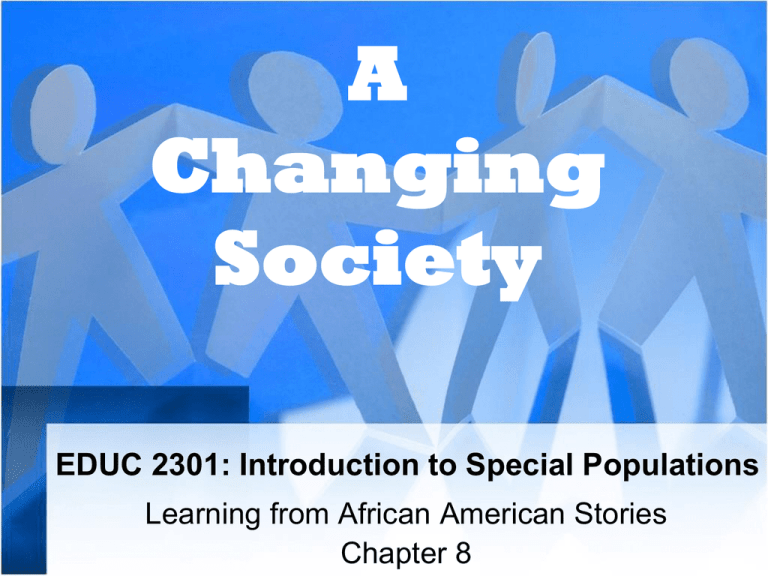
A
Changing
Society
EDUC 2301: Introduction to Special Populations
Learning from African American Stories
Chapter 8
LEARNING FROM AFRICAN AMERICAN
STORIES
… Wait, be patient,” you say.
“Your folks will have a better day.”
But the swirl of the bitter river
Takes your words away.
“work, education, patience
Will bring a better day.”
The swirl of the bitter river
Carries your “patience” away.
Langston Hughes, The Collected Poems of Langston Hughes, p.
243–244
©2012 Cengage Learning.
All Rights Reserved.
CULTURAL FACTOR 1: HISTORICAL AND
CURRENT TREATMENT IN THE UNITED STATES
• Slavery resulted in a legacy that continues to shape
the current social identities of African Americans and
members of dominant culture. It provides context for
the current sociopolitical landscape and affects all
intercultural relationships in the United States.
• Slavery continued in the United States for more than
244 years. The awareness of this history of being used
by members of dominant culture continues to influence
the way African Americans feel about and act toward
dominant culture individuals and institutions.
• www.ted.com/talks/ben_dunlap_talks_ab
out_a_passionate_life.html
©2012 Cengage Learning.
All Rights Reserved.
Current Conditions
• 10 percent of African Americans were unemployed in 2008 (up
from 7.6 percent in 2000) compared to 5 percent of whites
unemployed in 2008 (up from 3.5 percent in 2000).
• The annual median income in 2006 of African American
households was $31,969 compared to the $50,673 median
income for white households.
• About 24 percent of African Americans have incomes that fall
below the poverty level in the United States compared to 8 percent
of white Americans who live in poverty.
• An estimated 28 percent of black males enter State or Federal
prison during their lifetime, compared to 16 percent of Latinos and
4.4 percent of white males.
• Multi-generational family instability resulting from absent
fathers impacts African American children with only 35% living
with two married parents (compared to 76% European
American and 65% Latino).
CULTURAL FACTOR 2: INITIAL TERMS OF
INCORPORATION INTO U.S. SOCIETY
• African Americans and their ancestors, who
suffered slavery and who historically have
been denied true assimilation into U.S. society,
are categorized as "involuntary minorities" in
the United States based on their initial terms of
incorporation into society.
• Large numbers of African immigrants (Nigeria,
Kenya) and African refugees (Sudan, Somalia)
have settled in the U.S. in recent years
voluntarily.
©2012 Cengage Learning.
All Rights Reserved.
CULTURAL FACTOR 3: SHARED VALUES
AND TRADITIONS
• African Americans typically value family closeness
(including among extended-family members).
• A fictive kinship often exists among African Americans
that forms close and lasting "family" relationships
between African Americans who are not biologically
related. In this way, African Americans are able to pull
together as a community to support and care for one
another.
• Another system central to the maintenance and
promulgation of these values is the church.
• Many single fathers give lip service to intending to
support and care for their children, but studies show that
large percentages drop out of their children’s lives .
©2012 Cengage Learning.
All Rights Reserved.
CULTURAL FACTOR 4: VIEW OF
SPIRITUALITY AND HUMANS' RELATION TO
NATURE
• Many African American abolitionists, such as Frederick Douglass
and those who followed, including Martin Luther King Jr., Jesse
Jackson, Bishop T. D. Jakes and others, have worked within the
community of African American churches to provide support and
resources for African Americans in their march toward social
justice and opportunity.
• The African American church has been embraced by African
Americans as a rock in a weary land—a shelter from societal
mistreatment—often providing the only institution in society within
which members feel safe, free to be themselves, and expect no
discrimination.
©2012 Cengage Learning.
All Rights Reserved.
CULTURAL FACTOR 5: ACCULTURATION AND
EXPERIENCE WITH EXCLUSION AND ALIENATION
• Among involuntary minority group members,
instrumental adaptive responses are ways in which
these individuals may try to cope with their limited
access to jobs, wages, education, housing, and wealth
in the United States and in their effort to make a space
for themselves in dominant culture.
• African Americans may also utilize expressive adaptive
responses to respond to societal discrimination. For
example, cultural inversion or passing may be
responses exhibited.
©2012 Cengage Learning.
All Rights Reserved.
CULTURAL FACTOR 6: LANGUAGE
DIFFERENCES, STRENGTHS, AND CHALLENGES
• In general, African Americans tend to be more dramatic
and expressive in their speech and language patterns.
During communication, African Americans may be
more person-oriented than object- or topic-oriented.
• It is often assumed that African American Vernacular
English (AAVE) represents incorrect pronunciations
and grammar usage of the English language. Instead,
such formats have been found to incorporate patterns,
symbols, and meanings that are elements in a specific
linguistic system.
©2012 Cengage Learning.
All Rights Reserved.
POTENTIAL BARRIERS IN LEARNING–TEACHING
RELATIONSHIPS WITH DOMINANT-CULTURE TEACHERS
AND SCHOOLS
• African American families and students may display
suspicion related to the ways African American
students are treated in schools.
• Their mistrust of the system is formed by what has
been called a healthy paranoia when it comes to their
interactions with society's institutions—including
schools.
• Their ambiguity is often interpreted by school
authorities as a lack of care and concern for their
children's education.
©2012 Cengage Learning.
All Rights Reserved.
The Lost Boys of Sudan
• http://vimeo.com/26288723
2011
Dallas 2001
For Reflection and Discussion
1. How might historical treatment of African
Americans in the United States affect current
African American student orientations to
schooling?
2. What is cultural inversion and how might it
affect African American student achievement?
3. Is it conceivable that African American
teachers would not be received well by African
American students? Explain.
©2012 Cengage Learning.
All Rights Reserved.







